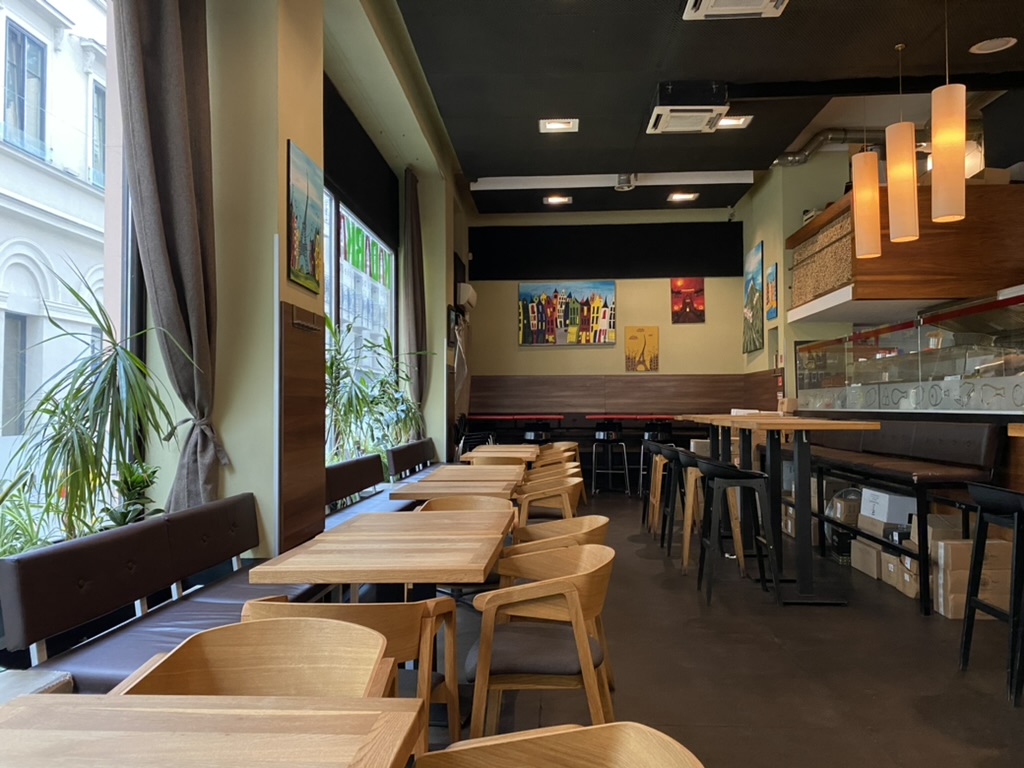Budapest wine bars have changed a lot. Some closed, new ones opened, but a few seem to be eternal.
For anyone who asks, I’m already listing the epitome of constancy (at least in the sense that they have been serving wine lovers in essentially unchanged places and ways for many years. Kadarka, Dobló in the party district. Zengő on the Mikszáth square, Drop Shop near Jászai, Palack wine bar on Gellért Square, DiVino at the Basilica (and for a few years now also in the Gozsdu courtyard) D.O.C. for Italian wine lovers. I know there are other wine bars in Budapest, and I can even list a few: Kóstolom, Szalonspicc, Ménesi Borbár, Vinikli, Takler Borbár Buda, St. Andrea, Gepárd és Űrhajó and I could go on. But I will introduce my favorite ones in this article and append other favorites every month to the bottom of this list.
What makes a wine bar?
Why do we distinguish it from restaurants and the institutional space of Hungarian alcohol consumption from the “kocsma” (pub)?
What distinguishes it from restaurants is mainly the food it serves. While in a restaurant, you can choose from a set menu of hot and cold starters, soups, main courses, and desserts. Most wine bars in Budapest offer hummus and other creams, which are easy to eat with bread, and a selection of cheese and cold cuts with olives and dried tomatoes. There is an evident Spanish and Italian influence.
How can wine bars be distinguished from “kocsma”?
For centuries, kocsma was where the local landlord and, sometimes, the servants (jobbágyok) could sell their wine. They also became the most important places for local social interaction, especially in winter. You can translate kocsma to pub. However, it doesn’t have the same connotations as the English counterpart word. Kocsma has survived world wars, revolutions, regimes, and regime changes. However, the wines available here were not, for the most part, known for their quality.
In my childhood, the village pubs also sold ice cream, so I sometimes found myself in these establishments. I used to look with one eye at the two or three containers from which the barman was pouring wine with a handled measuring cup. The measuring cups were suspended from the rims of the tanks, and the tanks were sealed with a pot lid-like fitting. The white was measured from one tank and the red from the other, possibly dry white from one and semi-sweet white from the other. These were rarely drunk neat by local consumers; practically everyone drank spritzers (fröccs). The smaller measuring glass was used to pour into the porter for the small splash (kisfröccs) and the larger one for the large splash (nagyfröccs). One of the most critical features of pubs in the past and still today is that they do not offer quality wines. The wine in pubs is generally in the €5 per bottle price range.
The most typical snack in Hungarian kocsma is bread with fat. These are usually served with raw onions cut into half rings, proving that you don’t come to the pub to enjoy the finest wines. So, regarding food, kocsma is a far cry from Spanish tapas bars or British pubs.
The Hungarian wine bars that opened after the turn of the millennium no longer serve a relatively narrow range of wines from bottles rather than from tanks, and offer a tidy, longer, or shorter wine menu. Most wine bars offer wines from at least 5 or 6 Hungarian wine regions, but in many cases many more from several producers.
What do we look at in a wine bar?
Location
Easy accessibility is essential, especially by public transport (after all, who would take the car home). Obviously, everyone would like to have their favorite wine bar within walking distance, but I accept that for me, this is a dream, as I live in the suburbs of Budapest. We also have to consider that different neighborhoods attract different types of people. Of the wine bars presented, some are on the Pest side, some are on the Buda side, some are in the party district, and some are in quieter neighborhoods.
Wine selection
Finding a wine bar where you can taste all 22 Hungarian wine regions is hard. Some of our favorite wine bars deal primarily with non-Hungarian wines, but we are now looking at our favorites that deal with Hungarian producers. So in our introduction, we will cover which wine bars are strong in which wine regions.
We appreciate if there is a wider selection of producers and if the wine bar offers the Hungarian varieties and blends. Furmint and Olaszrizling are a must and when it comes to Hungarian red wines we are looking for Bikavér (Bull’s Blood), Kadarka, Kékfrankos and Villányi Franc.
Food (just in case)
When it comes to food, our expectation of a wine bar is that they offer easy-to-grasp (even by hand), non-obtrusive flavor accompaniments that can stand up well even in food-drink pairings.
Atmosphere
When it comes to ambiance, we really are omnivores. Modern, cozy, classic, trendy or rustic – it doesn’t matter, have fun.
Price range
A not insignificant part of the experience is whether the elevated ambiance is weighed down by a hefty bill at settlement or whether we find the experience is commensurate with the value the operator is asking for.
So let’s see our favorite wine bars in Budapest.
DiVino Bazilika
Member of the DiVino network is located next to the Basilica. The other Budapest network unit is situated in Gozsdu Udvar and has outlets in several major Hungarian cities.
The four or five bar stools to the right of the entrance, next to the tables, offer a fantastic view of the Basilica. And in summer, from the tables in front of the shop, you can watch the hustle and bustle of the square as the nature of the crowd changes entirely over time.
Location of DiVino Bazilika
Excellent. Easy access from Deák Square or Arany János Street. There are two metro lines, the underground, numerous bus and trolley bus stops, and tram number 2, 47, and 49 stops not far away. Although the square in front of the Basilica is usually crowded, I wouldn’t say it’s overcrowded except during Advent. The DiVino shop in the Gozsdu courtyard cannot say the same.
The service is competent and not at all intrusive.
Servings are 1.5 decilitres by default, which the waitpeople generally need to take more seriously.
Wine selection of DiVino Bazilika
One of the most well-balanced wine bars in Budapest. Tokaj, Villány, Szekszárd, Eger, and the Lake Balaton area are predominant, but there are also a good number of wineries from wine regions little known abroad: Sopron, Neszmély, Somló, Pannonhalma, Mór, Mátra, and Etyek are also represented with one or two wineries.
In terms of Hungarian varieties, almost everything can be tasted. Besides Furmint, Kékfrankos Villányi Franc, and Bikavérek, fragrant Hungarian varieties and sometimes even Fekete Járdovány, brought back from research institutes into production by the A. Gere Winery are also served.
Food
They are so in tune with the Spanish lineage that their menu is called tapas. The ham platter is vibrant, and the cheese platter is a variety of great cheeses.
Atmosphere
As mentioned in the introduction, the atmosphere is primarily defined by the Basilica and the surrounding square (St Stephen’s Square). Still, if you head deeper into the building’s interior, you find yourself in a wine bar designed for an industrial interior, defined by wood, metal, and dark grey painted metal elements. In this section, the seating and tables are uncomfortable. I, for example, at two meters tall, find it hard to find room for my legs.
Price range
It’s adequate for the place.
Dobló wine bar
The name is a merger of the syllables of the streets. Located on the corner of Dob (Drum) and Holló (Raven) streets in the party district, this wine bar has been a personal favorite of mine for years. A good eight years ago, we were still entertaining friends here after marriage with my wife.
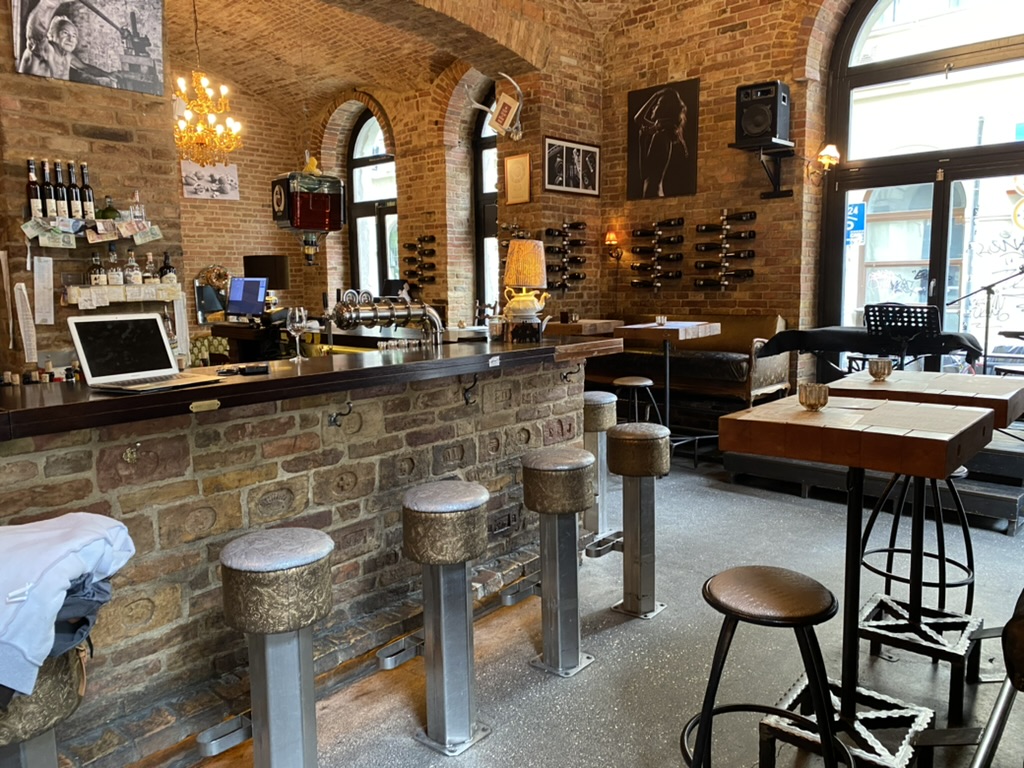

Location of Dobló
In the heart of the party district (District VII), it is easily accessible from Deák Square and Astoria but not too far from Nagykörút on foot (max. 8 minutes).
The only disadvantage compared to the other wine bars is that it does not have a terrace due to the narrowness of the streets, which is well compensated by the tables in the windows.
In the afternoon, the party district is more peaceful at this time of day, as if slight drowsiness descends on the place, and then a wilder scene as the evening approaches.
The wine selection of Dobló
The Hungarian wine regions are nicely covered, although none are pronounced. The wineries that can be tasted are usually represented by 1-2 lots. Regarding quality, the only thing that helped us on our last visit was the price, but I do remember occasions when the waiters gave detailed and exhaustive explanations of the items we tasted.
In terms of whites, we tasted Furmints, Olaszrizlings, Szürkebarát, Irsai Olivér, and Kéknyelűt, but also rarities such as the Szagos Sárfehér from Somló. Of the international varieties, there is a greater emphasis on Riesling (4 lots when we were there) and Chardonnay. All of them are from Hungarian producers at home or abroad.
Kékfrankos is the most important of the reds, but only one Bikavér (Bull’s Blood) is on offer. We were surprised by the high proportion of Pinot Noirs (4 lots) while only two Kadarka wines can be tasted.
Food
In terms of food, this is the bar with one of the broadest range of offerings of the bars we have just recommended, but the backbone of the selection here is still the cured hams and salamis, and cheeses. However, you can also get hummus, homemade liver pâté, duck liver soaked in cognac, or even a “Balkan sandwich”.
Atmosphere
Dobló is not very spacious, but that’s what gives it its charm, with rows and columns of raw bricks and chandeliers that are large for the space.
You can choose comfortable armchairs, bar stools, or even benches in the windows.
Unfortunately, the service was a little intrusive on our visit, but we put that down because there was only one other table (we arrived at 3pm on a Monday afternoon).
Price range
Unfortunately, the biggest surprise was the price, which was the equivalent of 3-4 Euros for 0.5 decilitres of wine, and the more significant portion (1.5 decilitres) was directly proportional to the smaller quantity, which we thought was not the most favorable pricing policy.
Kadarka wine bar
Another wine bar in the party district that we have visited for years and can only recommend to everyone.
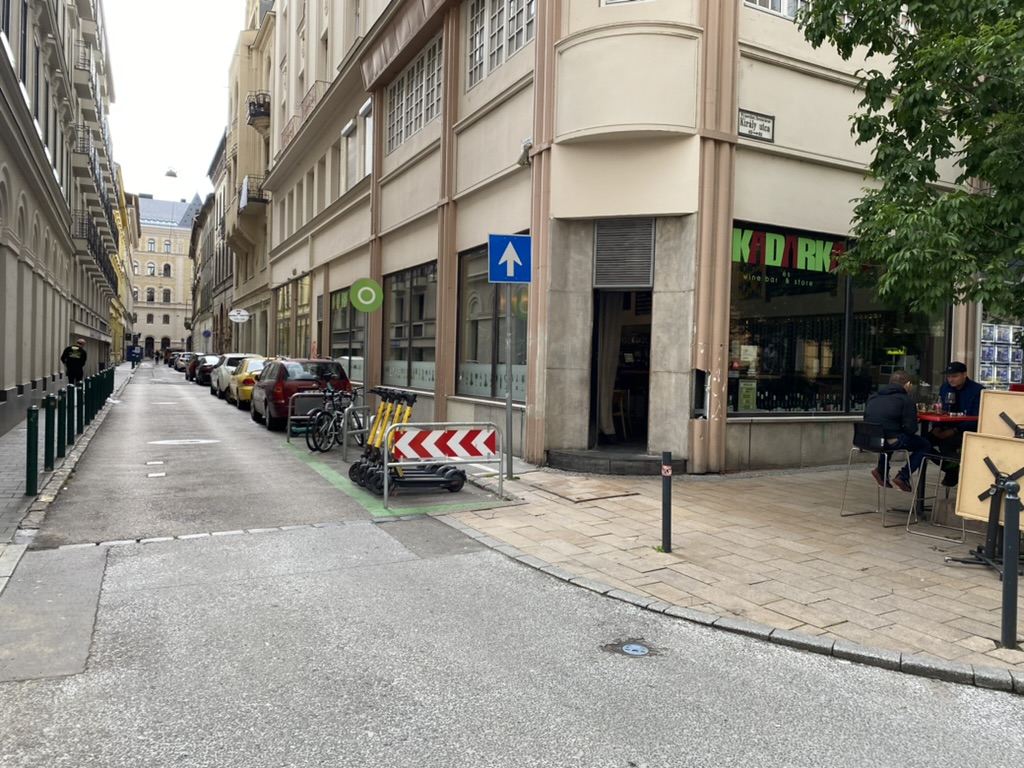
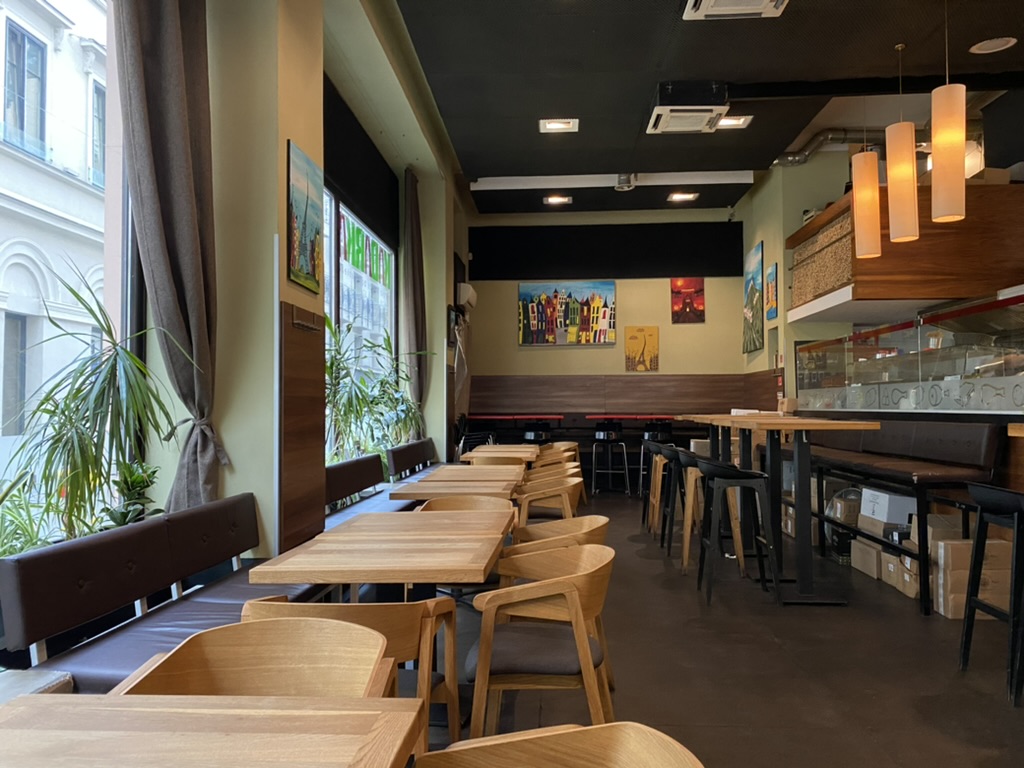
Location of Kadarka
Király Street is one of the most important streets in the party district, it’s one of the entrances to Gozsdu Udvar, and it leads from Deák Square all the way out to Dózsa György Road, so if you feel like clearing your head after a glass of wine, go for it. Of course, the street changes. Beyond the Nagykörút (Great Boulevard) you can see the other side of Teréz- and Erzsébetváros, and from Lövölde Square, the street is called Városligati Fasor, you can admire one of the most impressive residential areas of the city.
A shaded terrace makes Kadarka the perfect choice for summer evenings. I could spend endless hours at the high tables and bar stools.
The wine selection of Kadarka
The wine bar is named after the indigenous Hungarian red wine grape variety Kadarka, but before anyone is in any doubt, the list of whites is as long as the list of reds. In addition to a few rosés, we can also taste the Hungarian curiosity, the sillers, mainly from Szekszárd and one from Eger.
As far as whites are concerned, Tokaj and the immediate surroundings of Lake Balaton and the Somló wine region will take the lion’s share. We can also taste Ság Hill Olaszrizling and Riesling from the latter wine region. Ság Hill is the lesser-known volcanic mountain of the Somló wine region, partially mined in the 20th century but fortunately not wholly. The character of their wines is even more volcanic than Somló’s, which is why the wines of Ság Mountain are called “Vesemosó” (literally means:kidney washer).
Regarding red wines, the focus is on Szekszárd, perhaps partly because it is the wine region responsible for promoting the bar’s namesake, Kadarka. It is obviously an indication of this ambition that I counted no fewer than seven Kadarkas in the selection, five from Szekszárd and one each from Eger and Ménes (now a wine region in Romania, near Arad).
In addition to Szekszárd, the red wines of Eger are more numerous, and there are also one or two red wines from Villány, Pannonhalma, Mohács, Pécs, and Pannonhalma.
As for sparkling wines, the list is almost exclusively made by Hungarian producers.
The sweet whites section, obligatory in a Hungarian wine bar, was handpicked with confidence from Tokaj and Balaton (Nyáry Winery). And it’s also reassuring for me that the Hungarian names of the different proportions of the fröccs are also presented in the drinks list.
Food
You can dine out at Kadarka more elaborately than at the other wine bars featured. They don’t stick to cheese and ham platters but offer 3 kinds of soups, burgers, and a few simple main courses. I wouldn’t call Kadarka a restaurant, but the menu is well put together enough to make you want to spend your dinner on the spot instead of going to a restaurant with more substantial food after a few hours of wine tasting.
Atmosphere
Kadarka has a modern city atmosphere. Wooden tables, comfortable chairs, and benches under large window panes create a truly relaxing environment. The furnishings are not ostentatious but complementary, a spectator to the hustle and bustle of the vendors. The staff is non-intrusive, knowledgeable, humorous and contributes to an excellent evening.
Price range
I am impressed by the progressive pricing, which is in contrast to Dobló’s pricing policy, whereby if you order larger, you pay less (0.75 dl, 1.5 dl and 0.75 l portions, the latter even for takeaway)
Zengő wine Bar
A discovery for me in recent months, they opened this bar a bit more than three years ago, but it seems like they’ve always been there in Krúdy Gyula street.
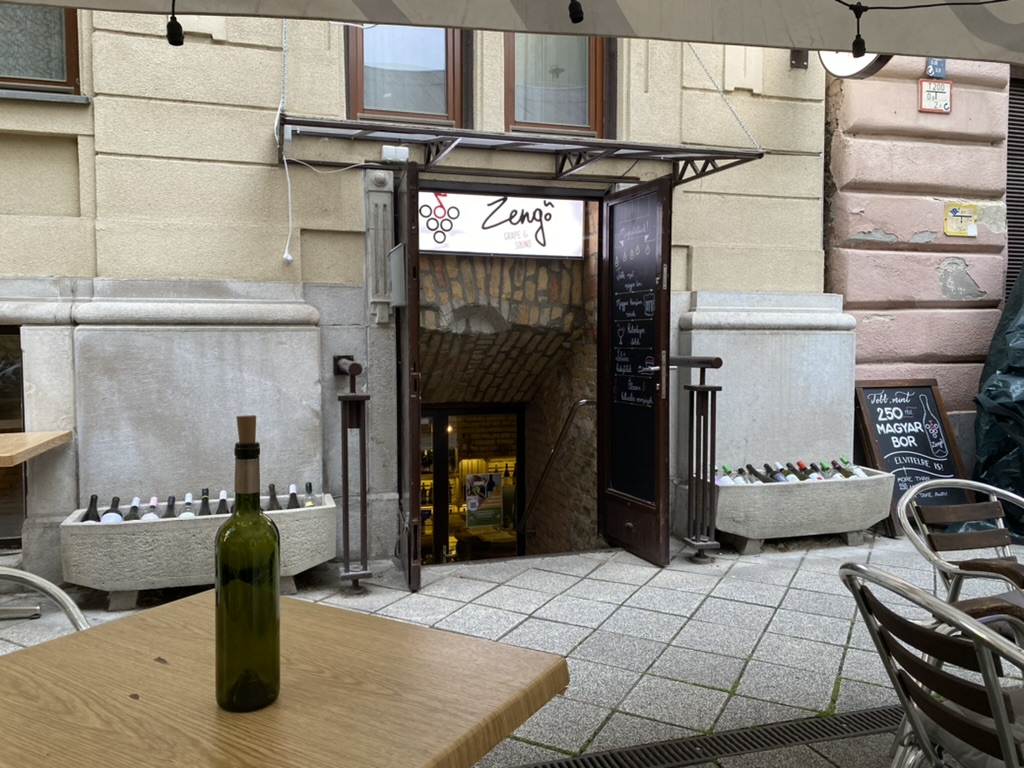
Location of Zengő Wine bar
Mikszáth Kálmán Square in District VIII and its surroundings were already an important gathering place for party-goers in the 1990s, mainly due to the cult that developed around the then “Tilos az Á” club. And the Krúdy Gyula street, which runs from the square towards the Nagykörút, has always been a place for restaurants, pubs, and exotic clubs. The street is already a cobbled street, sheltered from the traffic from Lőrinc Pap Square, where you can enjoy a refreshing or thought-provoking wine among the tall shady buildings.
Public transport is the easiest way to get there from Nagykörút, but the bus stops at Kálvin tér, and Rákóczi út are not far away.
The Wine selection of Zengő wine bar
The number of items available by the glass is perhaps the lowest of the wine bars featured here, with 10 whites, 7 reds, 3 sparkling wines, and two rosés and dessert wines. However, a total of 250 wines can be tasted if you buy the whole bottle. Although the lack of Aszú and/or Szamordni and Bulls’ blood by the glass is a sore point for me, there is instead amphora Cabernet Franc and Pet Nat among the sparkling wines and a traditional Somló blend from Fehérvári Winery.
The bar has also put together a 5-5 lot white and red tasting series and a 6 lot “mix” series in 0.5 dl*5 (or 6).
Food
The food here is also called tapas, a sign of direction. We chose the antipasti platter for two and were not disappointed.
Atmosphere
The terrace is clearly more pronounced in the Zengő wine bar than the interior, designed with a distinctly cellar-like feel. Under the brick-lined arches, the raw wood color dominates the space, as both the counter and the interior compartments for the presentation of the bottles are made of untreated wood.
The staff is knowledgeable, with short, to-the-point recommendations that will make you want what they offer.
Price range
Zengő is not the cheapest wine bar in terms of prices, but it is far from the most expensive. The uniqueness of the items on offer is reflected in the pricing.

